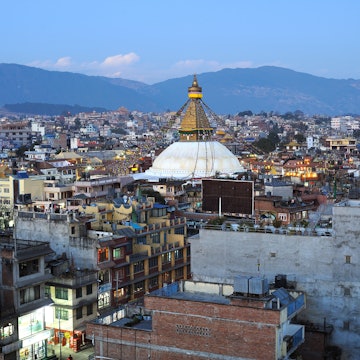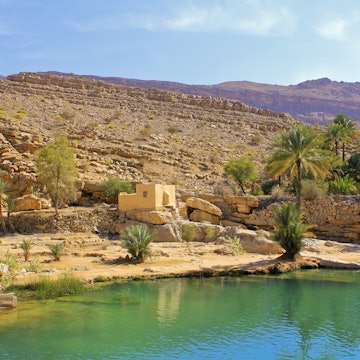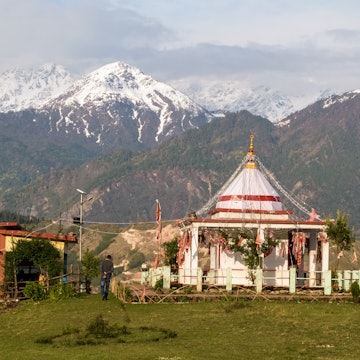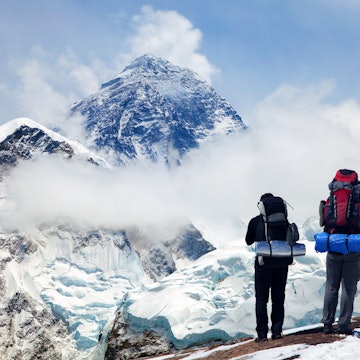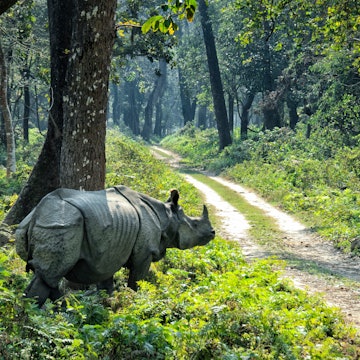

Broad Peak base camp on the trek to K2. World Explorers/Shutterstock
The K2 base camp trek in Pakistan is one of the world's greatest hikes. Trekkers follow a rocky trail that winds up the mighty Baltoro Glacier, passing through a colossal amphitheater of sky-scraping summits – including seven of the 19 highest mountains on the planet – en route to the base of the world’s second-highest peak. Feet twitching? Here’s everything you need to know about hiking to K2 base camp.
Introducing K2 and the Karakoram mountains
The spectacular Karakoram mountains of Pakistan are home to some of the wildest landscapes on Earth. And while tides of eager walkers flood the trails of Nepal, Pakistan receives just a trickle of trekkers in comparison. But the Greater Ranges of Asia span many borders. While the classic Himalayan routes of Everest and Annapurna may steal the limelight, the Karakoram trails of northern Pakistan are no less magnificent.
The crown of the Karakoram is K2. At 8611m (28,251ft) it is the world’s second-highest mountain and an expedition to its base camp at 5150m (16,896ft) makes for one of the most exciting walks in the world. Beginning in the remote village of Askole, the trail winds its way along the grand Braldu Valley before mounting the Baltoro Glacier to Concordia. Positioned 12km (7.5 miles) from K2, Concordia is one of the few places on Earth where it’s possible to see four 8000m (26,247ft) peaks from one place: K2, Broad Peak, Gasherbrum I and Gasherbrum II.
Unlike the approach to Everest base camp in Nepal, where trekkers are treated to only teasing glimpses of the iconic summit, K2 is unimpeded by its satellite peaks, and instead stands imposing, watching over all who tackle the trail to its base. K2 may be second in height and notoriety to Everest, but as a spectacle, it is second to none.

Trekking to K2 base camp
The K2 base camp trek takes 14 days in total (up and down), and starts in the village of Askole. Once away from this small green oasis, the mighty Karakoram doesn’t take long to reveal its beauty. Serrated summits and towering cliffs rear up either side of the wide valleys. By the end of the first day trekkers are camped beneath the distinctive peak of Bakhor Das, affectionately referred to as Mango Peak, due to its curiously shaped summit cone.
The following day the remarkable granite spires of Trango Towers and Cathedral rear up, standing sentry over the trail for three days. Once onto the Baltoro Glacier the first 7000m peaks (22,966ft) – Masherbrum and Muztagh Tower – appear. Despite their dominance, it’s not long before the first 8000m peaks (26,247ft) emerge on the horizon. At the end of Baltoro Glacier stands the Gasherbrum Range, a massif of five peaks over 7000m including two above 8000m.
Another day of walking brings trekkers to the huge rocky amphitheater of Concordia that makes the European ranges look puny in comparison. The eye is immediately drawn from the Gasherbrums, across the wide summit ridge of Broad Peak to the sharp and abrupt pyramid of black rock ridges and glinting snow gullies of K2. On this night, trekkers pitch their tents at one of the finest campsites on the planet.

The following day trekkers have a choice of how to approach K2 base camp. They can make the exhausting round-trip from Concordia in a day. However, the more popular option is to hike to Broad Peak base camp and stay for the night. The following day is then a far more agreeable push to K2 base camp and back.
K2 base camp is not the sea of yellow tents and prayer flags that’s found at the foot of Everest. There are no iconic signs; instead a modest rockpile marks the site. Depending on the time of the season and the number of expeditions, hikers may well find they’re alone at base camp. There, at the foot of over two vertical miles of rock and ice, the second-highest mountain on Earth stands proudly as reward for over a week of toil.
Depending on their itinerary, trekkers either return to Askole back down the Braldu Valley or head towards the high pass of Gondogoro La (finishing the trek in the village of Hushe). While the Gondogoro La pass provides an alternative perspective of the Karakoram, it also proves quite the challenge. Trekkers should be confident with an ice axe and crampons and willing to rise at the stroke of midnight to take on the high pass.
Whichever route one opts for, a trek through Pakistan’s mighty Karakoram to the foot of the world’s second-highest mountain, is one of the world’s classic – and currently lesser-tackled – high-altitude adventures.

Practical information
Pakistan has long-been touted as tourism’s "next big thing," but alarming headlines have often discredited those predictions. There are economic, political and security problems, and a mixed reputation beyond the country's borders. However, this is where visitors will find some of the most hospitable people in the world. Start planning your K2 trek with our essential travel tips.
Distance: The trek takes around 14 days in total and, while no specialist equipment is required, climbers should be fit and healthy and have tackled at least one high-altitude climb before. Additionally, opting to tackle the Gondogoro La pass requires some basic rope work and the use of an ice axe.
Camping: The only accommodation available throughout the trek is camping. Tents are two-person affairs so solo travelers should expect to share. Campsites are pitched either on rock, ice or both, so make sure to pack a thick, warm camping mattress. It should also be noted that most campsites do not have toilet facilities so prepare to do your business in the wild, following the principles of “leave no trace” (ie digging holes and burning toilet paper).
Equipment: It is common for porters to carry your personal gear. But this all depends largely on the level of service you pay for. The more expensive outfits provide chairs, dining table, toilet tent and full porterage. Cheaper outfits require clients to carry some or all of their personal gear and forego the other luxuries.
When to go: The best months for trekking in the Karakoram are July and August, although the trekking season runs from mid-June through mid-September. Outside of those dates excessive snow remains on passes and north-facing slopes, keeping any passes above 3000m (9843ft) closed. Unsurprisingly, the weather in the Karakoram can be changeable. Be prepared for a range of weather including wind, rain, snow and plunging temperatures, particularly at night.
Terrain: The terrain is far more challenging than the well-trodden trails of Nepal. On the Baltoro Glacier trails are constantly changing as the ice shifts and crevasses open up, so a degree of cross-country walking is to be expected. It’s also not unusual for rivers to swell to excessive levels or wash away footbridges, so be prepared to get your feet wet.
Access: To trek to K2 base camp foreigners must have a licensed guide with them and obtain various permits – your trekking company will be able to advise. The trek begins at Askole, which is a 6-hour drive via 4WD from Skardu, which itself is a short domestic flight from Islamabad (journey time: one hour). Trekkers can leave excess luggage in Skardu at their guesthouse. Most visitors to Pakistan require a visa; more information is available on Pakistan's official visa portal.
Safety and security: Despite recent improvements, foreign governments still advise against travel to several areas of Pakistan. Seek up-to-date advice from your government on the situation in the areas you plan to visit before traveling.
This article was originally published November 2019.





